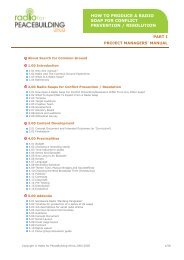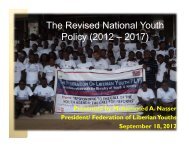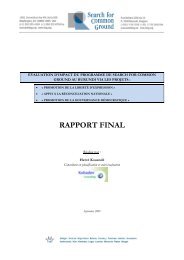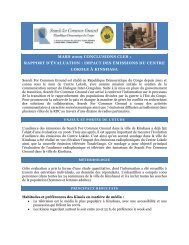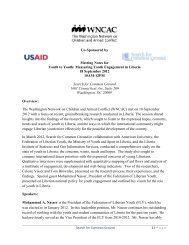The Common Ground Network for Life and Choice Manual
The Common Ground Network for Life and Choice Manual
The Common Ground Network for Life and Choice Manual
You also want an ePaper? Increase the reach of your titles
YUMPU automatically turns print PDFs into web optimized ePapers that Google loves.
Pro-life -------------------------------o------------------------------- Pro-choice<br />
• Connective thinking: <strong>Common</strong> ground dialogue encourages connective thinking that focuses attention on the<br />
strengths, the pieces of wisdom <strong>and</strong> truth, in what is said. This is the opposite of critical thinking <strong>and</strong> debate, in<br />
which listeners hone in on the speaker’s weaknesses <strong>and</strong> prepare <strong>for</strong> a response.<br />
• Genuine questions: Genuine questions are those <strong>for</strong> which we truly seek answers. Rhetorical questions are<br />
those <strong>for</strong> which we already know the answer. We throw rhetorical or leading questions out to test or trap an<br />
opponent. When the opponent gives the wrong answer, we score a victory. Only genuine questions belong in a<br />
common ground process.<br />
• Active listening: One problem encountered in a conflict over strongly held beliefs is that people tend to talk<br />
past one another. <strong>The</strong>y also frequently answer a question not asked instead of the one actually posed.<br />
Typically, people feel that no one on the “other side” has ever really listened to, or acknowledged, them. One<br />
way to address these dynamics is to encourage participants to reflect back to one another what they hear being<br />
said, or asked. This is a paraphrase or summary, or an acknowledgment of an emotion that is being conveyed.<br />
In an e-mail conversation, while everything is in writing, there is still the potential <strong>for</strong> ignoring or<br />
misinterpreting another’s remarks.<br />
Why dialogue via e-mail?<br />
For several years now, the <strong>Network</strong> has organized workshops <strong>for</strong> dialogue on abortion <strong>and</strong> has assisted interested<br />
persons in organizing <strong>and</strong> sustaining ongoing local groups. While these avenues have been very successful, time<br />
<strong>and</strong> again we hear that people who would like to participate in a dialogue group can't, because such a group doesn't<br />
exist in their area, or because their schedule doesn't allow them to attend meetings. For people who fall into one of<br />
these categories, dialogue via e-mail is a solution.<br />
How will the group work?<br />
By now, you have probably realized that this group is not going to be your typical LISTSERV discussion group.<br />
<strong>The</strong>re are some similarities, mechanically speaking. Your e-mail address will be stored on a list by our computer.<br />
You will send messages to the list address, which redirects your message to everyone on the list. That's where the<br />
commonality ends, however. Here is a brief breakdown of the aspects of our e-mail group that will ensure a healthy<br />
<strong>and</strong> productive dialogue.<br />
Facilitation. A facilitator will be present on the distribution list. <strong>The</strong> role of the facilitator will be to set the pace of<br />
the dialogue by posing questions <strong>and</strong> to ensure that the ground rules are respected. <strong>The</strong> facilitator will not monitor<br />
your questions be<strong>for</strong>e they go out to the group, but will give direct feedback <strong>and</strong> guidance when needed. What this<br />
means in practical terms is that the facilitator may let people know that he or she feels the line has been crossed into<br />
attempts to convert, or into disrespect. <strong>The</strong> facilitator may need to remind a participant to speak as “I” instead of<br />
“we”. Or the facilitator may ask someone to rephrase a question that is overly rhetorical or provocative into a<br />
genuine question of curiosity. <strong>The</strong> facilitator might also suggest some active listening or ask <strong>for</strong> specific examples<br />
or experiences if it seems people are having trouble underst<strong>and</strong>ing a response. <strong>The</strong> facilitator is also available to be<br />
contacted directly by any participant who becomes concerned about how the dialogue is going.<br />
Pace of the dialogue. <strong>The</strong> pace of the dialogue will be slow but consistent. <strong>The</strong> facilitator will pose a dialogue<br />
question <strong>and</strong> then every participant will give one response. Next the facilitator will ask a follow up question or<br />
request a clarification, to which every participant will also give one response. At the facilitator's discretion,<br />
dialogue will move to a new question using the same sequence. This "convey <strong>and</strong> response" style may seem very<br />
slow, but will prevent the "free <strong>for</strong> all" that often undermines the quality <strong>and</strong> discipline of dialogue in other on-line<br />
discussion groups.<br />
Participants will not merely be present on our distribution list, but will be asked to have a presence in the<br />
group. <strong>The</strong> facilitator will initiate a question or other prompt every two days. This means making the commitment<br />
to checking your e-mail once every other day <strong>and</strong> staying engaged in the discussion.



